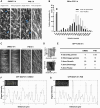A cellulose synthesis inhibitor affects cellulose synthase complex secretion and cortical microtubule dynamics
- PMID: 38833284
- PMCID: PMC11376392
- DOI: 10.1093/plphys/kiae232
A cellulose synthesis inhibitor affects cellulose synthase complex secretion and cortical microtubule dynamics
Abstract
P4B (2-phenyl-1-[4-(6-(piperidin-1-yl) pyridazin-3-yl) piperazin-1-yl] butan-1-one) is a novel cellulose biosynthesis inhibitor (CBI) discovered in a screen for molecules to identify inhibitors of Arabidopsis (Arabidopsis thaliana) seedling growth. Growth and cellulose synthesis inhibition by P4B were greatly reduced in a novel mutant for the cellulose synthase catalytic subunit gene CESA3 (cesa3pbr1). Cross-tolerance to P4B was also observed for isoxaben-resistant (ixr) cesa3 mutants ixr1-1 and ixr1-2. P4B has an original mode of action as compared with most other CBIs. Indeed, short-term treatments with P4B did not affect the velocity of cellulose synthase complexes (CSCs) but led to a decrease in CSC density in the plasma membrane without affecting their accumulation in microtubule-associated compartments. This was observed in the wild type but not in a cesa3pbr1 background. This reduced density correlated with a reduced delivery rate of CSCs to the plasma membrane but also with changes in cortical microtubule dynamics and orientation. At longer timescales, however, the responses to P4B treatments resembled those to other CBIs, including the inhibition of CSC motility, reduced growth anisotropy, interference with the assembly of an extensible wall, pectin demethylesterification, and ectopic lignin and callose accumulation. Together, the data suggest that P4B either directly targets CESA3 or affects another cellular function related to CSC plasma membrane delivery and/or microtubule dynamics that is bypassed specifically by mutations in CESA3.
© The Author(s) 2024. Published by Oxford University Press on behalf of American Society of Plant Biologists.
Conflict of interest statement
Conflict of interest statement. None declared.
Figures







Similar articles
-
CESA TRAFFICKING INHIBITOR inhibits cellulose deposition and interferes with the trafficking of cellulose synthase complexes and their associated proteins KORRIGAN1 and POM2/CELLULOSE SYNTHASE INTERACTIVE PROTEIN1.Plant Physiol. 2015 Feb;167(2):381-93. doi: 10.1104/pp.114.249003. Epub 2014 Dec 22. Plant Physiol. 2015. PMID: 25535279 Free PMC article.
-
Cellulose-Microtubule Uncoupling Proteins Prevent Lateral Displacement of Microtubules during Cellulose Synthesis in Arabidopsis.Dev Cell. 2016 Aug 8;38(3):305-15. doi: 10.1016/j.devcel.2016.06.032. Epub 2016 Jul 28. Dev Cell. 2016. PMID: 27477947
-
Anisotropic Cell Expansion Is Affected through the Bidirectional Mobility of Cellulose Synthase Complexes and Phosphorylation at Two Critical Residues on CESA3.Plant Physiol. 2016 May;171(1):242-50. doi: 10.1104/pp.15.01874. Epub 2016 Mar 11. Plant Physiol. 2016. PMID: 26969722 Free PMC article.
-
Regulation of cellulose synthesis via exocytosis and endocytosis.Curr Opin Plant Biol. 2022 Oct;69:102273. doi: 10.1016/j.pbi.2022.102273. Epub 2022 Aug 17. Curr Opin Plant Biol. 2022. PMID: 35987011 Review.
-
Cellulose synthases and synthesis in Arabidopsis.Mol Plant. 2011 Mar;4(2):199-211. doi: 10.1093/mp/ssq079. Epub 2011 Feb 9. Mol Plant. 2011. PMID: 21307367 Review.
Cited by
-
P4B: A novel probe to study cellulose synthesis and microtubule dynamics.Plant Physiol. 2024 Sep 2;196(1):12-13. doi: 10.1093/plphys/kiae305. Plant Physiol. 2024. PMID: 38788768 Free PMC article. No abstract available.
References
-
- Albersheim P, Darvill A, Roberts K, Sederoff RR, Staehelin LA. Plant cell walls, from chemistry to biology. New York, USA: Garland Science; 2012. 10.1201/9780203833476 - DOI
MeSH terms
Substances
Grants and funding
LinkOut - more resources
Full Text Sources

